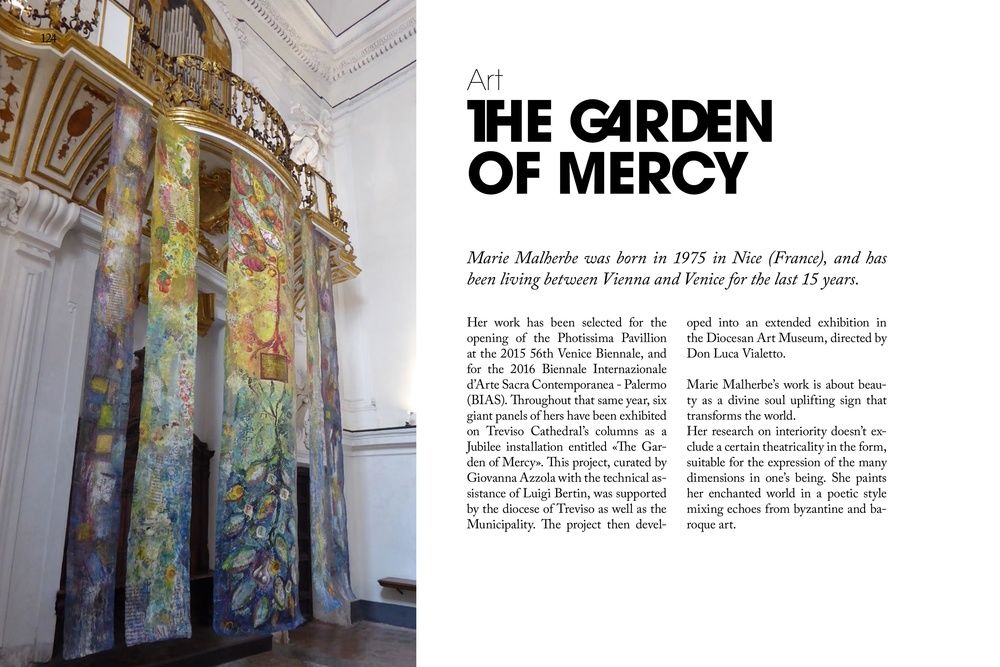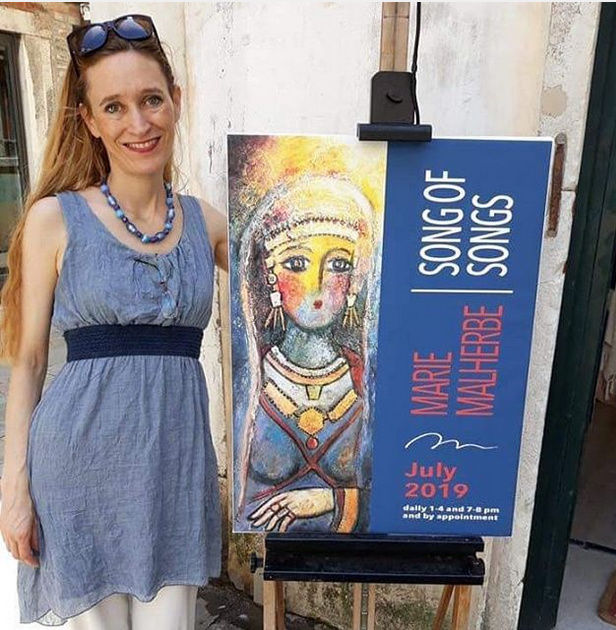Marie Malherbe
Museo ebraico di Venezia (translation) : If you visit the Venice Ghetto in these last days of July, do not miss the opportunity to be fascinated by the exhibition 'The Grace of Love': the works of the artist Marie Malherbe from Nice are all dedicated to the Song of Songs, the Shir ha Shirim of the Jewish tradition. The exhibition is open until the end of July at the IMAGOARS Gallery, in Campiello delle Scole in the Old Ghetto.
To present it, we borrow the words of our colleague Francesca Ruth Brandes:
"Works that burn, these of The Grace of Love by Marie Malherbe. Small incandescent caskets for a text of unusual carnality. The strength of the feminine element, the jubilation of nature make room for a hidden, inexpressible line, sometimes difficult to contain. Truth, in Marie's paintings, emerges implacably.
The Song of Songs is no light, serene work. It is written that Love is hard / Like Death; the light is hyper-defined, but the consistency is rock. The impulse, the vital impetus are even fearsome, in declaring that total passion, that all-encompassing love.
The artist proceeds luminously, but never loses sight of the code of verse. It is the 'very good and beautiful' matter as Genesis 1:27 and 31 claims, but it also conceals something else. There is the perfect understanding, in the image of God, in which the loving image is suspended in a shadowless Present, yet a higher, more complex desire than sensual immediacy is discernible.
Beyond interpretation, beyond any refined mimesis - which have always been figures of his formal and intellectual journey - what is striking is the transfiguration of the tale, the choice of the right key to access the mystery. The epiphany of the meaning of everything: joy, but also pain, death. Incredible to speak of death, in Marie's gardens, yet the signs are all there, because there is no life that knows no end; it is human finiteness that is sung, in the face of divine perfection. The rest is wonder, total trust, faith."
To present it, we borrow the words of our colleague Francesca Ruth Brandes:
"Works that burn, these of The Grace of Love by Marie Malherbe. Small incandescent caskets for a text of unusual carnality. The strength of the feminine element, the jubilation of nature make room for a hidden, inexpressible line, sometimes difficult to contain. Truth, in Marie's paintings, emerges implacably.
The Song of Songs is no light, serene work. It is written that Love is hard / Like Death; the light is hyper-defined, but the consistency is rock. The impulse, the vital impetus are even fearsome, in declaring that total passion, that all-encompassing love.
The artist proceeds luminously, but never loses sight of the code of verse. It is the 'very good and beautiful' matter as Genesis 1:27 and 31 claims, but it also conceals something else. There is the perfect understanding, in the image of God, in which the loving image is suspended in a shadowless Present, yet a higher, more complex desire than sensual immediacy is discernible.
Beyond interpretation, beyond any refined mimesis - which have always been figures of his formal and intellectual journey - what is striking is the transfiguration of the tale, the choice of the right key to access the mystery. The epiphany of the meaning of everything: joy, but also pain, death. Incredible to speak of death, in Marie's gardens, yet the signs are all there, because there is no life that knows no end; it is human finiteness that is sung, in the face of divine perfection. The rest is wonder, total trust, faith."


SONG OF SONGS opens up a glimpse into a new cycle of Malherbe's work, presenting around ten new works inspired by the sacred text of the Song of Songs and giving rise to what turns out to be one of the best artistic expressions of her signature style of painting. As art critic Francesca Brandes writes in the text inside the catalogue that accompanies the exhibition, these are "incandescent works for a thousand two hundred and fifty Hebrew words of unusual carnality, round and coloured fruit, absolute flowering. [...] The mirror of gazes, the strength of the feminine element, the jubilation of nature that accompanies the verses makes room, however - beyond the aesthetic balance - for the Hidden, the inexpressible. In the order of the Garden one glimpses, at a slightly longer glance, a wave of the absolute that leaves one astonished, in the face of so much truth'. He then adds that "Marie's material, as if exposed to a blinding light, hyper-defined in its consistency, leaves no room for doubt. It is a declaration of intent that conceals, at its deepest core, a treasure. Perhaps feared, as one fears the vital impetus, the courage to declare that total, all-encompassing love." Marie Malherbe thus uses, in her proceeding (so luminous as to verge on obscurity), the first, fundamental key of verse. The loving image is suspended in a dream, in a shadowless Present, in which time is not destined to pass. However, where the verses reveal a different reading plane, the artist makes us glimpse something other than the 'very good and beautiful' matter mentioned in the book of Genesis. Through his works, we grasp the absolute fascination of beauty, the harmony of the real that longs for, and is sometimes an unknown, unexpected longing. What is astonishing, in Malherbe's lucid dreaming, is the abandonment of objectivity. Beyond the exegesis (which is also punctual), beyond the study of pictorial symbolism, beyond the refined mimesis that has always been part of this artist's intellectual structure, what touches us is the transfiguration of words, the choice of the right key to access the mystery. Marie Malherbe knows and knows how to convey that Beyond in which the sensual love between a man and a woman is transformed into the seed of love - eternal and perfect, this one capable of transcending death - with which God welcomes living beings. It is a symbolic transmutation that is fundamental for understanding even the dreamlike suspension of the Canticle: love of the flesh, love of the soul, love of faith that all surpasses and contains at the same time. Finally, Brandes concludes by explaining that "of the mystery enclosed within the text that is fundamental to Christian mysticism, Marie grasps the declared peace, the total trust, the wonder. Like the Canticle, its works are revealed in successive stages: to our eyes, to the soul, to the mind that orders everything. To leave the last key - the most intimate, the most courageous - to the spirit."

Mug Magazine, #27, July 2017, p.125
Yearly ART Magazine published by LARRARI SAS Editore, www.lazzaristore.com
Mug Magazine, #27, July 2017, p.126
Yearly ART Magazine published by LARRARI SAS Editore, www.lazzaristore.comRete al Femminile Treviso |
#lenostrerecensioni
#retealfemminiletreviso
Marie Malherbe, Song of Songs
di Maria R. Tremigliozzi
I had the opportunity to visit French artist Marie Malherbe's exhibition at Campo del Ghetto Vecchio in Venice, a setting that provides an evocative backdrop to her cycle of paintings on the Song of Songs. Using mixed techniques ranging from oil on canvas to paper collage, the painter has depicted the most intense passages of this very special text, which is part of the Old Testament and sublimates, in poetic and passionate expressions, the love of a young couple.
The paintings are textural, very colourful, with profound symbolism evoking references to historical texts; an almost Giottesque blue recreates the tormented nights of the protagonist searching for her beloved, while soft colours and floral references accompany and accentuate the most tender moments of this ancient love story.
Marie Malherbe has succeeded in transfusing both the romanticism and the emotional tension of this poem into her works, making use of her studies on Byzantine art (the inner recollection of her figures, almost contemporary icons, is very particular) and applying cues and forms from the masterpieces of great artists such as Marc Chagall.
In the works of this painter, the search for spirituality is very important (her paintings adorned the columns of Treviso Cathedral during the Jubilee of Mercy) as a vital impulse to a deeper and freer existence; female art also characterises many of her works, which dwell on the preciousness and richness of the inner world of women, not just marginal figures relegated to the background but conscious protagonists of the history they are living.
#retealfemminile
Marie Malherbe, Song of Songs
di Maria R. Tremigliozzi
I had the opportunity to visit French artist Marie Malherbe's exhibition at Campo del Ghetto Vecchio in Venice, a setting that provides an evocative backdrop to her cycle of paintings on the Song of Songs. Using mixed techniques ranging from oil on canvas to paper collage, the painter has depicted the most intense passages of this very special text, which is part of the Old Testament and sublimates, in poetic and passionate expressions, the love of a young couple.
The paintings are textural, very colourful, with profound symbolism evoking references to historical texts; an almost Giottesque blue recreates the tormented nights of the protagonist searching for her beloved, while soft colours and floral references accompany and accentuate the most tender moments of this ancient love story.
Marie Malherbe has succeeded in transfusing both the romanticism and the emotional tension of this poem into her works, making use of her studies on Byzantine art (the inner recollection of her figures, almost contemporary icons, is very particular) and applying cues and forms from the masterpieces of great artists such as Marc Chagall.
In the works of this painter, the search for spirituality is very important (her paintings adorned the columns of Treviso Cathedral during the Jubilee of Mercy) as a vital impulse to a deeper and freer existence; female art also characterises many of her works, which dwell on the preciousness and richness of the inner world of women, not just marginal figures relegated to the background but conscious protagonists of the history they are living.





